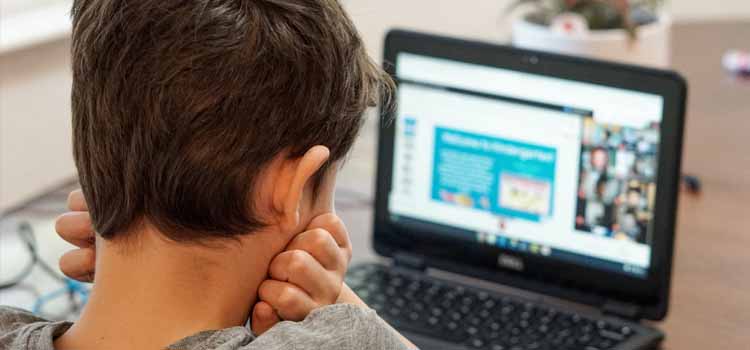Right to Education: Issues and Concerns in the Pandemic
Posted On : April 5, 2022

Table of Contents
CHALLENGES FACED BY THE STUDENTS
Access and participation
One of the major problems of distance education was the lack of access to the digital infrastructure among the students. A status report conducted by Oxfam India in September 2020, states that the children studying in government schools were hit particularly hard. More than 80% of students studying in government schools in the states of Uttar Pradesh, Bihar, Chhattisgarh, and Jharkhand did not receive any kind of educational materials during the lockdown. This was primarily due to no digital access.
The students in rural India who had access to digital devices also suffered due to lack of internet connectivity or inability to afford the price of the internet or poor internet speed/signals.
Health and well-being.
The students enrolled in government schools had access to midday meals program which provided them with necessary nutrition, which generally they maybe not be able to afford. With the closure of the schools, the students lost this important nutrition which might also affect their health.
The schools used to also conduct immunization drives, health checks, providing sanitary napkins, which are impossible to substitute with schools being closed.
Mental and Social Development
For children schools and colleges are far more than just attending classes. It’s also a place of play and interaction with children from different backgrounds. This is very important in their mental and social development. But due to the lockdown, the children were confined in their houses and had no peer-to-peer interaction. This resulted in their poor social skills and affected their mental and intellectual development.
A survey conducted by the Azim Premji Foundation of over 16,000 students in primary schools found that 92% of students lost at least one language ability, while 82% have lost their basic maths skills.
Financial problems
The pandemic hit the economy of India very hard and many people were left unemployed. Also, many sole-earners of their family lost their lives to the covid-19. It was observed that huge dropouts and students were discontinuing their studies due to the financial burden of education on their families.
Conflicting decisions of State governments, the Supreme Court and several High courts regarding ‘regulation of school fees’ worsened the crisis. Many Private unaided schools maintained their stance of charging 100% fee. While some states were able to impose certain relaxations and reductions, other states failed miserably. This led to many students being expelled or forced to drop out of schools.
CHALLENGES FACED BY TEACHERS
No Training
Very few teachers had prior training to take classes digitally. Due to this the teachers who were not properly trained, quality of teaching decreased. This also created a divide among students as some who had trained teachers received better quality of education than the others.
No government support.
The teachers felt they were not properly helped by the government. The teachers received no digital tools such as smartphones, laptops, proper internet connectivity, etc. The online teaching material was made available by the government, but the teachers were not properly trained to access them. In some states, the teachers did not even receive salaries for a few months.
Reaching Students.
The teachers were not able to reach all the students digitally due to the digital divide. They could also not visit the students personally who could not attend the classes digitally due to the pandemic.
Preference for in-person teaching.
Most of the teachers did not get accustomed to the new way of teaching and preferred the in-person classes. They felt that there was less interaction with the students and teaching was difficult, no matter how audio-visually striking the content was.
STEPS TAKEN BY THE GOVERNMENT
1. The Ministry of Education worked hard to make digital learning content available to all students. It also partnered with various organisations to make ed-tech available to students. Some of the government’s e-learning platforms are Digital Infrastructure for Knowledge Sharing (DIKSHA), Swayam, e-Pathshala and the National Repository of Open Educational Resources (NROER).
2. The Central Government created the policies, their implementation lies on the state governments. Therefore, the response to digital learning varied from state to state. For instance, the state of Gujarat focused on distributing QR codes of online learning materials to the students, while States like Uttar Pradesh and Bihar where internet connectivity is not that good focused on learning programmes on Television; Assam distributed worksheets to the students; Kerala too focused on distributing textbooks and teaching through WhatsApp.
3. The Central Government also brought the scheme of Pradhan Mantri Garib Kalyan Anna Yojana (PMGKAY) which provided free rations to the ration-card holders till March 2022. It provides 5kgs of rice or wheat and 1kg of dal per person of each family. It provided a big help to vulnerable sections of the society and their children would not be forced to look for jobs to provide food for the family.
4. The Union Cabinet approved the National Education Policy (NEP) in July 2020 under the Ministry of Education. The NEP aims at an ambitious overhaul of the current education system and makes it modern and resilient, as India is preparing to come out of the pandemic.
5. The Mass Vaccination drive launched by the Government has now vaccinated almost 75% of the adult population in the country. The fast vaccination drive has helped in reducing the severity of the pandemic and due to this the schools and colleges in the country have now started reopening for in-person learning.
6. The government in May 2021 announced a special PM Cares for Children scheme for all those children orphaned due to Covid-19. It supports the education of all the children orphaned due to Covid-19 by providing them admission to the nearest Kendriya Vidyalaya or private school and bearing all their fees. It also supports the higher education of such children by providing them with educational loans whose interest will be borne by the PM Cares Fund. It also tries to help the students economically by allocating a corpus of Rs. 10 lakhs in the form of a fixed deposit in the name of the child. This amount will also be used to provide a monthly stipend to the child from the age of 18 years to 23 years and provide the lump amount after 23 years.
Various state governments also brought in their schemes for the children orphaned due to covid-19.
7. The new financial budget which was presented on February 1, 2022 has emphasized the education sector and is seeking to bridge the gap which has been created by the digital divide during the pandemic. According to it, ‘Digital University’ are to be set up and it will be made available in different languages. Also, ‘One class, One TV channel’ with 200 channels is sought to be created to provide supplementary education in all regional languages.
SUGGESTIONS FOR FUTURE
The pandemic hit every aspect of human lives hard, but slowly and steadily we are overcoming it. The planning should now focus on how to avoid such pandemics and build the system in such a way that the devastation is much less compared to what happened this time.
The pandemic showed us the defects of the current education system and the focus should now be to build back better. Some suggestions for it are:
Reduce the Digital Divide.
The internet has now become a necessity for human life. Access to information has now become easier than ever. The pandemic showed how badly the students suffered due to a lack of digital access. The Central and State governments should now focus on increasing internet connectivity in rural areas. It will benefit both students, as well as the teachers as access to learning materials, would become easy.
Teacher Training.
The teachers are the cornerstones of the education system. They should be trained to access the learning materials online and should also be trained on how to teach digitally. This training is essential as, if any such event happens in the future the teachers will not be in shock and the education sector will not suffer as much as it did this time.
Health and Hygiene.
The pandemic has shown us the importance of maintaining proper hygiene habits. The government, once in-person teaching resumes, should focus on making the school and college campuses hygienic and inculcate such habits in the students too. This will not just help in preventing Covid-19 but also other diseases among the students.
Focus on the Marginalised Sections.
Due to the unemployment of their parents and lack of education during the pandemic, many children would have been forced to drop out of the schools and colleges. This has further pushed them back by years in their upliftment process. The government should now focus on their recovery and bringing them back into the education system.
Data Collection.
Surveys should be conducted and data should be collected by the government to make targeted investments in the education sector. Also, by improving the electrical and internet facilities the government can now make provisions for real-time data collection from the schools and colleges. This will help them in understanding the issues of the educational institutions better and speedy resolution of the issues.
CONCLUSION
Governments may act right now to keep and safeguard the teaching force. First and foremost, they must guarantee that instructors are paid and that the school is prepared to reopen quickly if approval is granted. Second, they may improve school health and safety by increasing sanitation and providing guidance on problems such as hand washing and health education. Finally, kids can substitute conventional extended vacations with an extra school session to make up for their missed time. Governments may even experiment with more permanent adjustments to the traditional school calendar, blending local community rhythms with a teaching and learning timetable that maximizes the time children and instructors spend together. The coronavirus outbreak was a shock to the system, but it is unlikely to be the last. Governments must keep the long-term goal in mind, ensuring that all children and young people in low- and middle-income nations receive an education. To guarantee a healthy, affluent, and safe future, we must ensure that educational systems are appropriately funded, that technology is used wisely, and that teachers are protected.
The teachers and the students along with the government made huge efforts to overcome the challenges posed by the Covid-19 pandemic in the education sector. As normalcy is slowly being restored the focus should now be both on the future and the recovery of students who suffered due to the divide brought by the pandemic.
“The highest education is that which it does not merely gives us information but makes our life in harmony with all existence”
– Rabindranath Tagore
Bibliography
- Oxfam India in September 2020 : More than 80% of students studying in government schools in the states of Uttar Pradesh, Bihar, Chhattisgarh, and Jharkhand did not receive any kind of educational materials during the lockdown.
- Right to Education Act (RTE) 2009 : Free and compulsory education is a fundamental right of every child of age 6 to 14 years.
- Azim Premji Foundation : 92% Kids Lost Language Skills, 82% Lost Math. Its State of Emergency in Education: Anurag Behar






















